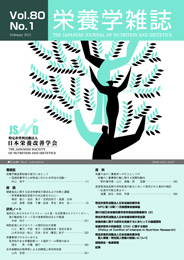
- Issue 6 Pages 295-
- Issue 5 Pages 273-
- Issue 4 Pages 219-
- Issue 3 Pages 149-
- Issue 2 Pages 79-
- Issue 1 Pages 1-
- |<
- <
- 1
- >
- >|
-
Etsuko Kibayashi, Makiko Nakade, Ayumi MorookaArticle type: Original Article
2022 Volume 80 Issue 6 Pages 295-306
Published: December 01, 2022
Released on J-STAGE: January 13, 2023
JOURNAL FREE ACCESSObjective: To clarify dietary practices for lifestyle disease prevention by sex and age, among young and middle-aged regular breakfast eaters.
Methods: The subjects of this cross-sectional study were 984 respondents (men; 45.7%) to the 2016 Hyogo Diet Survey, aged 20~59 years. Subjects were categorized into regular breakfast eaters (≥4 days per week) and non-regular eaters. The demographic characteristics and whether they implemented each dietary practice for lifestyle disease prevention were compared according to sex and age using the χ2 test. A binomial logistic regression analysis was performed using whether or not subjects ate breakfast as the independent variable according to sex and age, adjusted for age, family composition, BMI, and history of lifestyle disease.
Results: Logistic regression analysis showed significantly higher odds ratios in regular breakfast eaters than that in non-regular breakfast eaters for "having a well-balanced meal at least twice daily" in both men and women aged 40~59 years (odds ratio [95% confidence interval]; 2.41 [1.04~5.62], 2.75 [1.08~6.96]), "restricting salt intake" (2.91 [1.21~6.98]), "eating a lot of vegetables" (3.76 [1.73~8.17]) in men aged 40~59 years, and "having a well-balanced meal at least twice daily" in men aged 20~39 years (2.83 [1.33~6.05]).
Conclusion: Eating breakfast regularly was associated with eating well-balanced meals in men aged 20~39 years and both men and women aged 40~59 years, and with restricting salt intake and eating a lot of vegetables in addition to eating well-balanced meals in men aged 40~59 years.
View full abstractDownload PDF (787K)
-
Himeno Sameshima, Rie Akamatsu, Fumi Hayashi, Yukari TakemiArticle type: Informations
2022 Volume 80 Issue 6 Pages 307-316
Published: December 01, 2022
Released on J-STAGE: January 13, 2023
JOURNAL FREE ACCESS
Supplementary materialObjective: We aimed to examine the characteristics of healthy meals with low environmental impact using nitrogen footprint (NF) to promote food choices that contribute to both global environment and health.
Methods: We calculated NF using the N-Calculator method using dietary data from 602 Smart Meals in the restaurants and ready-made meal section of the "Healthy Diet and Food Environment" certification system. We divided the meals into five groups (Q1, Q2, Q3, Q4, and Q5) with NF adjusted per 650 kcal. Then, we compared the amount and appearance rate of food groups using the chi-squared and Kruskal–Wallis tests among the five groups.
Results: A total of 509 meals were analyzed (analytic rate 84.6%). The NF per meal ranged from 9.46 to 48.89 g-N/650 kcal. The protein source food group had the highest percentage of NF among all five NF groups. The Q1 group, which had the lowest NF, used more potato/starch, sugar/sweeteners, seaweed, seafood, and oils and fats, and less vegetables, meat, and dairy than the other groups. The appearance rate of protein source food groups such as beef, pork, chicken, seafood, soybeans/processed foods, and eggs in the Q1 group was 0.0%, 12.9%, 4.0%, 89.1%, 48.5%, and 38.6%, respectively.
Conclusion: Even healthy diets made according to the same criteria differed in NF. Healthy diets with low NF mainly used protein source food groups other than meat.
View full abstractDownload PDF (898K)
- |<
- <
- 1
- >
- >|